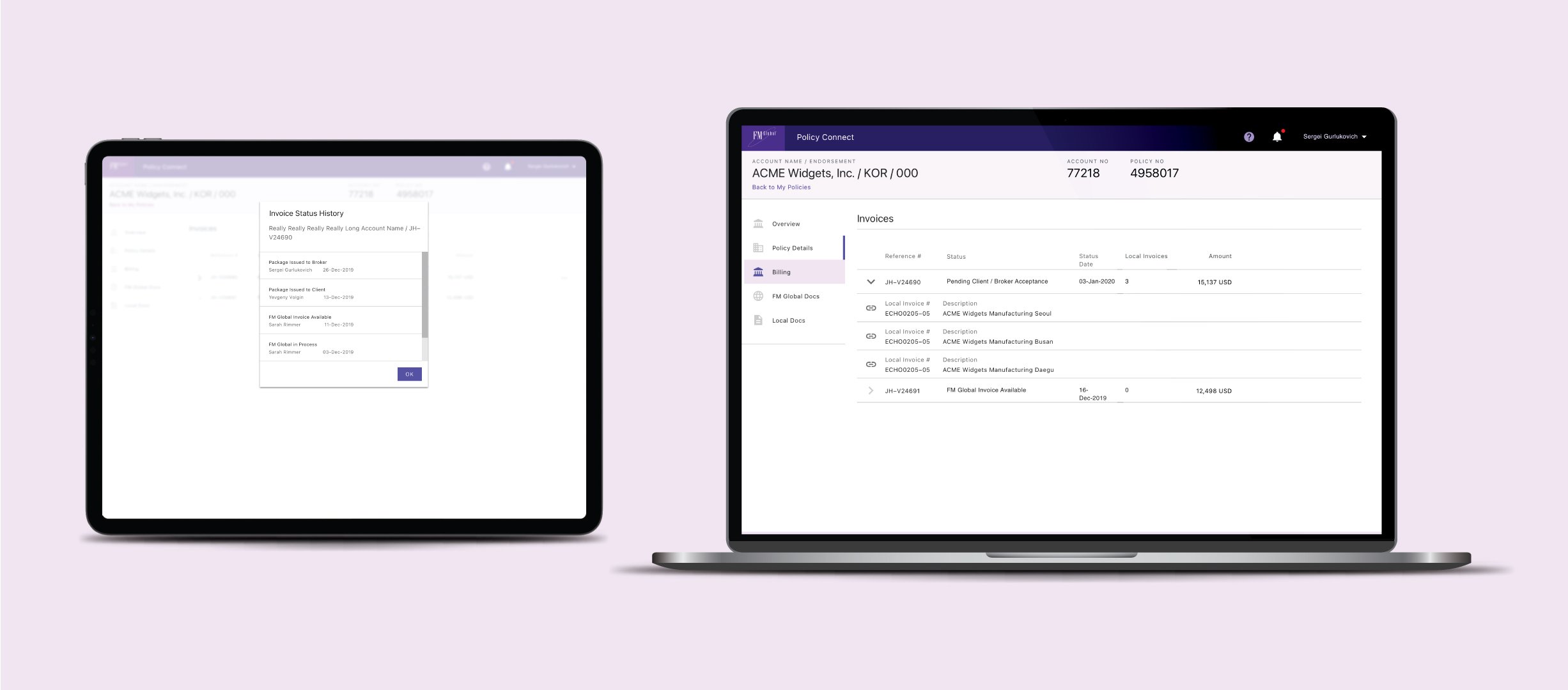
FM GLOBAL WorldReach PARTNERS INVOICES
Reduction in payment delays, increased satisfaction among financial teams, retention of clients, and the impact the new payment process had on operations and suggestions for future initiatives.
Issuing invoices to WorldReach Partners (WRP) has been straightforward for years. However, knowing when receipt of payment by a WRP—or when a WRP has split or issued an invoice to a local client in an unlicensed territory—was frustrating at best.
For FM Global’s Global Processing Group, it became a manual fact-finding nightmare.
ROLE
User Experience (UxR) Researcher, User Experience (UX) Designer, Interaction (IxD) Designer, User Interface (UI) Designer, and Visual Designer
TIMELINE
2018 - 2020 (Two Years)
TOOLS
Sketch, Illustrator, Photoshop
Overview
For years, our Global Processing Group (GPG) faced challenges in tracking payments from our WorldReach Partners (WRP). Payment reliability was often compromised due to inefficient and manual systems, affecting our business's financial health and client relationships.
The primary aim was to improve visibility, communication, and automation in the Billing section of the Policy Connect platform. By achieving this, we intended to facilitate real-time information sharing among teams and improve overall efficiency.
Challenges:
Communication Across Teams: Difficulty in easily communicating payment status between multiple teams.
Reliance on WIT: Current reliance on the World Insurance Tracker (WIT) tool for manual invoice tracking.
Manual Processes: Use manually updated spreadsheets and rely on institutional knowledge and finance teams for information.
User Experience: Need to display information meaningfully that FM Global Operations Teams can leverage.
Strategic Interventions:
Centralized Dashboard: Notification System with real-time tracking and instant information dissemination.
API Integration with WIT: Transition to an automated, unified system leveraging existing tools and streamlining processes.
Automation/Machine Learning: Cloud-based real-time databases reduce human error and ensure data consistency.
User-Centered Design: Iterative feedback loops with End Users. Tailoring interface to user needs. Continuous improvement through user feedback.
Inadequate internal systems combined with manual processes are compromising the reliability of information. As a result, current policyholders are struggling to track their invoices accurately, and our WorldReach Partners are also experiencing a suboptimal experience when policies are issued to them. Based on research insights, there is a clear opportunity to enhance the invoice experience for all involved parties.
Research
We laid a strong foundation for optimizing the payment tracking experience for WorldReach Partners and FM Global Operations Teams. We've identified critical user needs and pain points using 500 interviews from 50 WRP offices worldwide. Through user interviews, iterative prototyping, surveys, and concept testing, we've identified critical pain points and formulated UX design strategies. However, the following steps are imperative to ensure our solution is robust and genuinely user-centric.
Next Steps & Rationale
Data Synthesis: Perform a thorough analysis of the qualitative and quantitative data gathered from interviews and surveys to identify common patterns, challenges, and user expectations.
Refined Prototyping: Given that the budget is not a constraint but time is MVP-centric, focus on rapid prototyping for quick validation of the design elements that are most critical to the user experience.
Feedback Integration: Iterate on the prototype using the results from initial user interviews and surveys. Implement agile methodologies to make regular updates based on this ongoing feedback.
Extended User Testing: As we iterate on the prototype, plan another round of user testing specifically targeting the previously identified pain points to measure how well the new design addresses them.
Stakeholder Alignment: Keep business stakeholders and end users involved through periodic updates and seek their feedback to align the project better with organizational goals and user needs.
API Integration Planning: Since one of the future goals is to allow WRPs to connect their financial APIs to our systems, initiate early planning and documentation for this phase.
User-Centric Solutions Through Personalization
We have set the stage for a transformative experience that aims to solve critical issues around payment tracking for both WorldReach Partners and FM Global Operations Teams. While we have successfully highlighted broad concerns through initial user interviews, surveys, and concept testing, we acknowledge that our user base is diverse, with varying needs, goals, and challenges.
Our next pivotal step is to develop detailed user personas to create a product that genuinely solves real-world problems across this varied user landscape.
By meticulously crafting user personas based on these characteristics, we aim to create a user-centric platform that addresses each user group's unique needs, expectations, and challenges. This approach will ensure that our solution is universally intuitive and individually accommodating.
How will identifying unique user types inform our design solutions?
How can understanding specific user goals and pain points guide our design decisions?
How do cultural, social, and geographical variables influence user expectations and interactions?
How will understanding the demographics of our user base refine our user personas?
How do the comfort level and access to technology among users affect their interaction with the product?
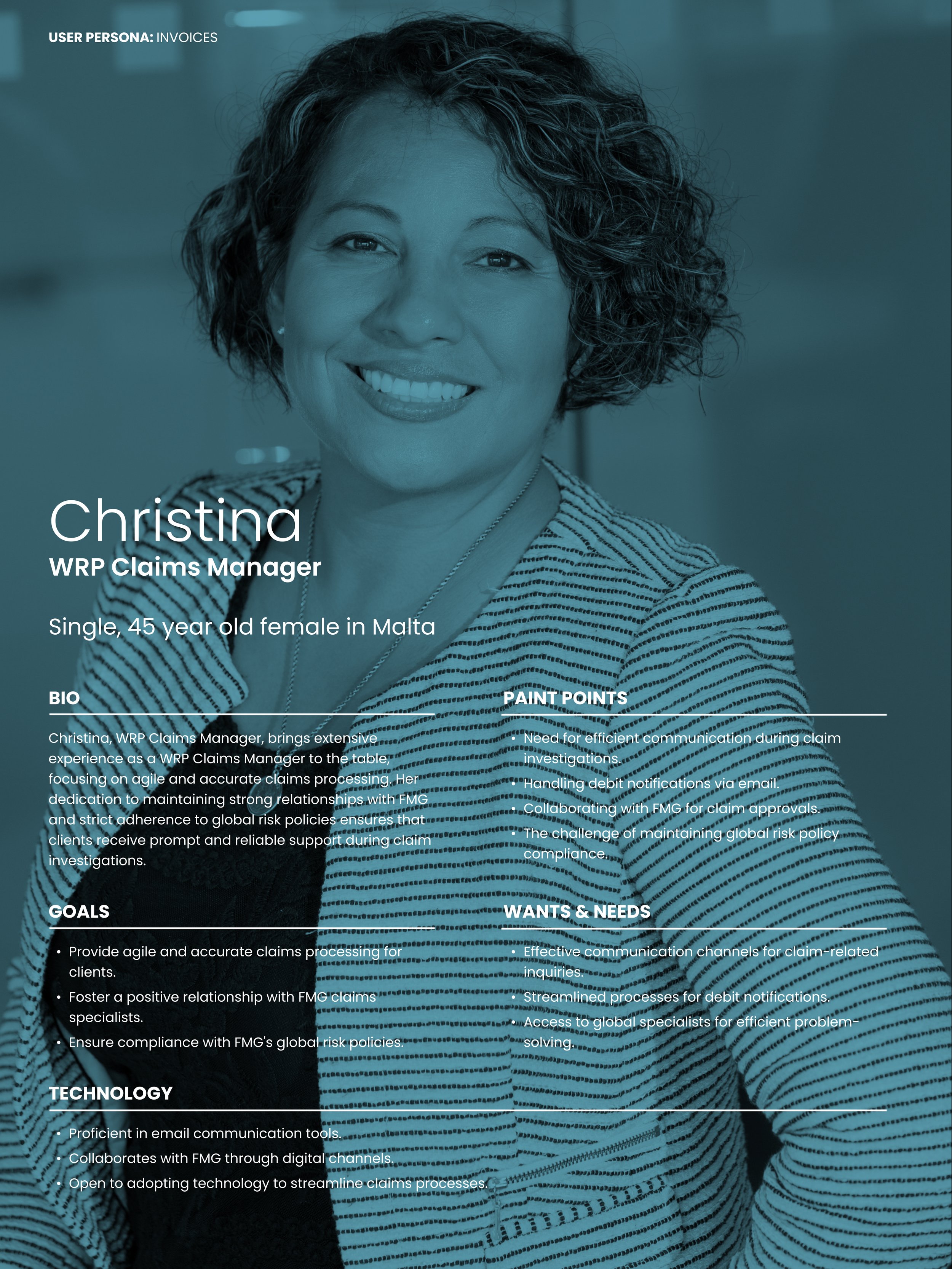
Christina, WRP Claims Manager Handling debt notifications via email
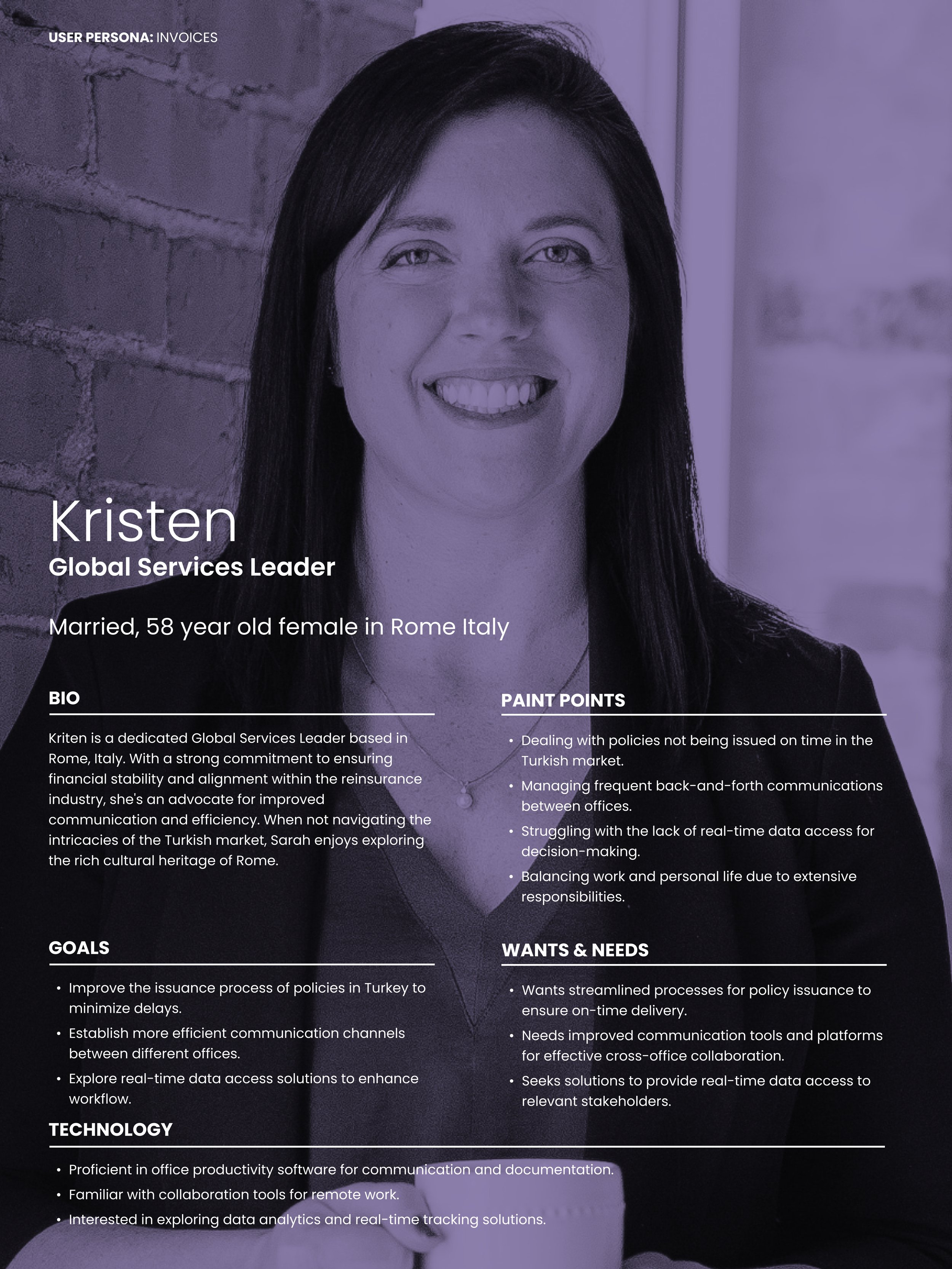
Kristen, Global Services Leader Managing frequent back-and-forth communications between offices
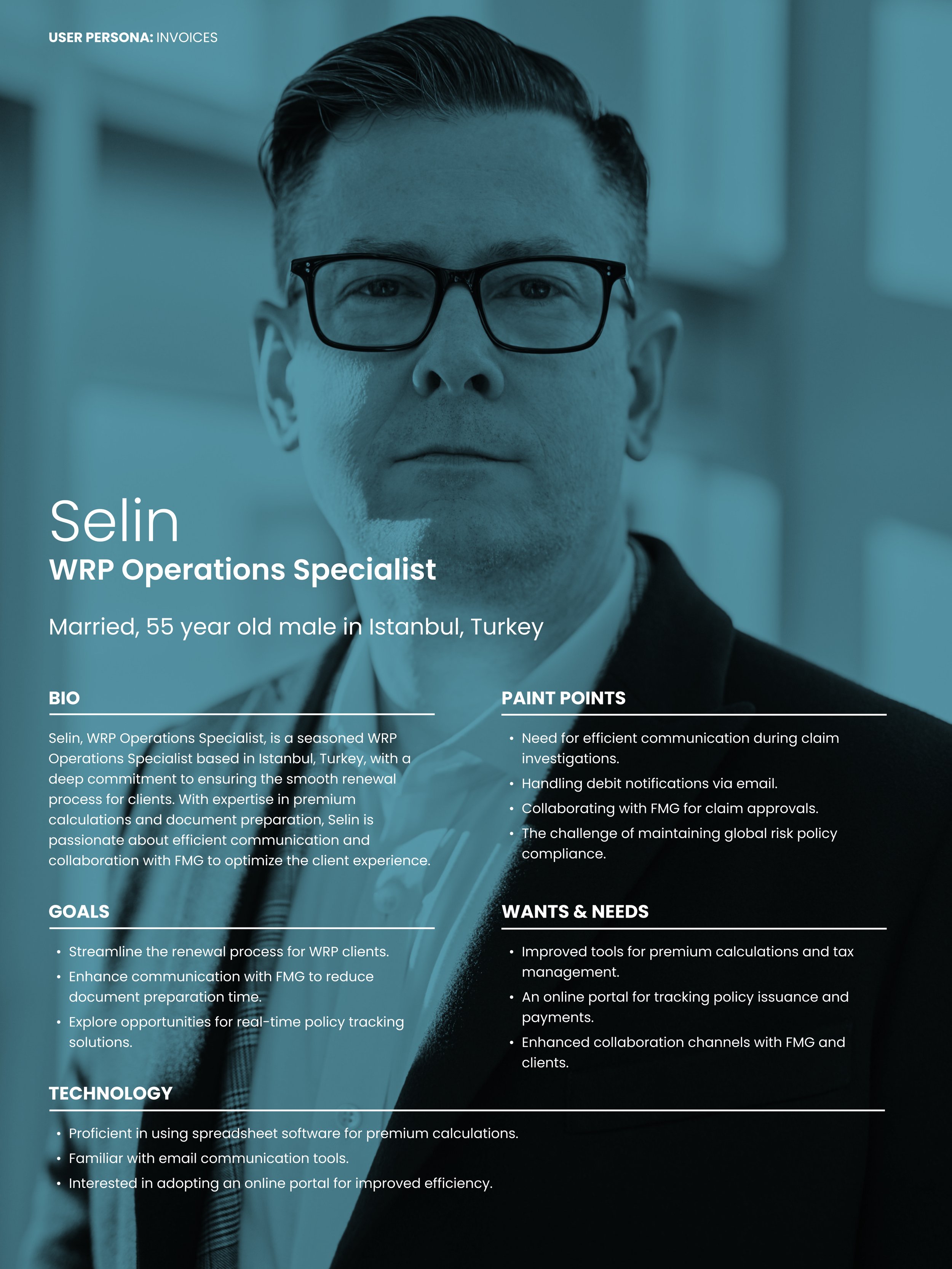
Selin, WRP Operations Specialist Need for efficient communication during claim investigations
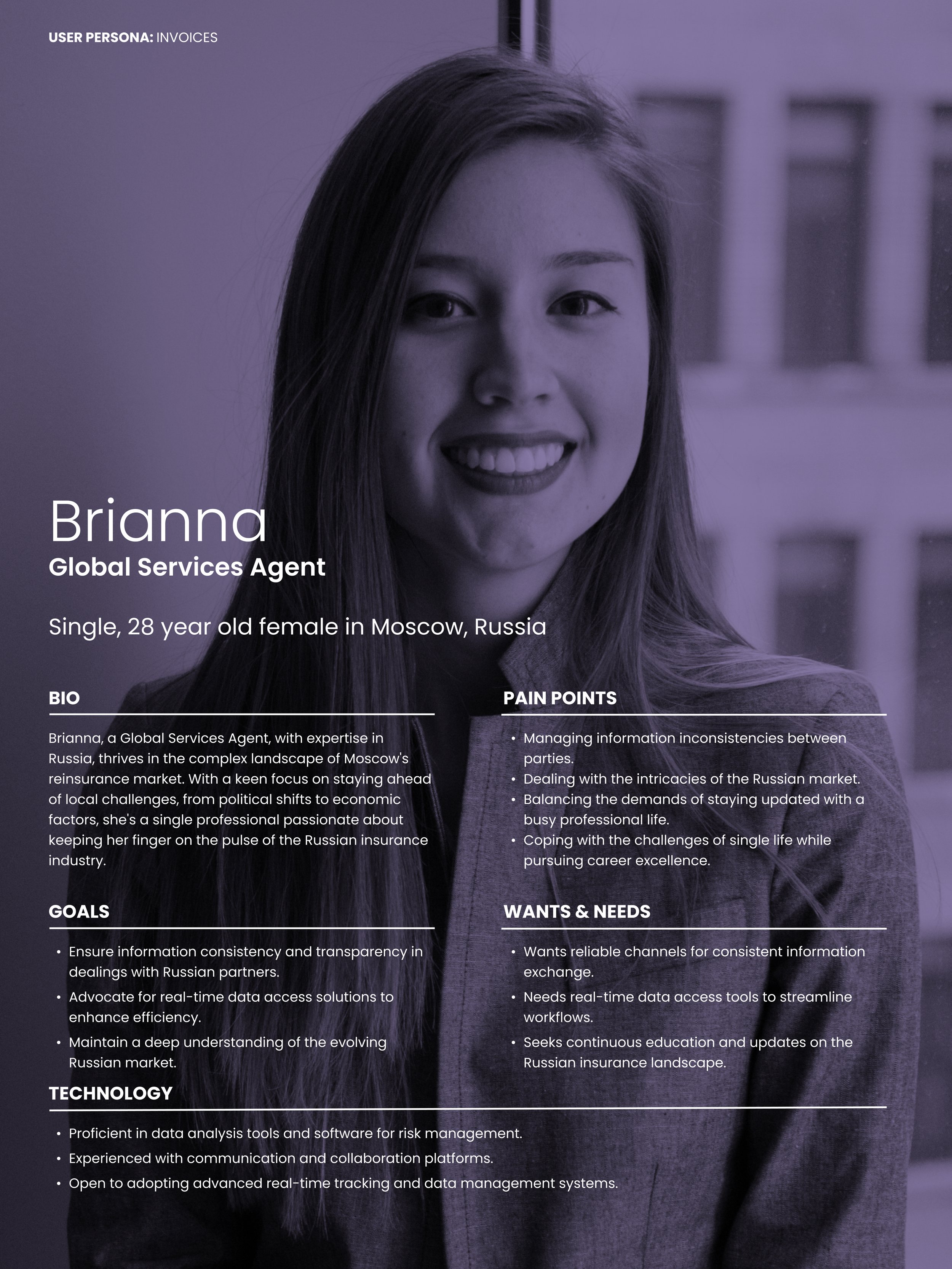
Brianna, Global Services Agent Managing information inconsistencies between parties
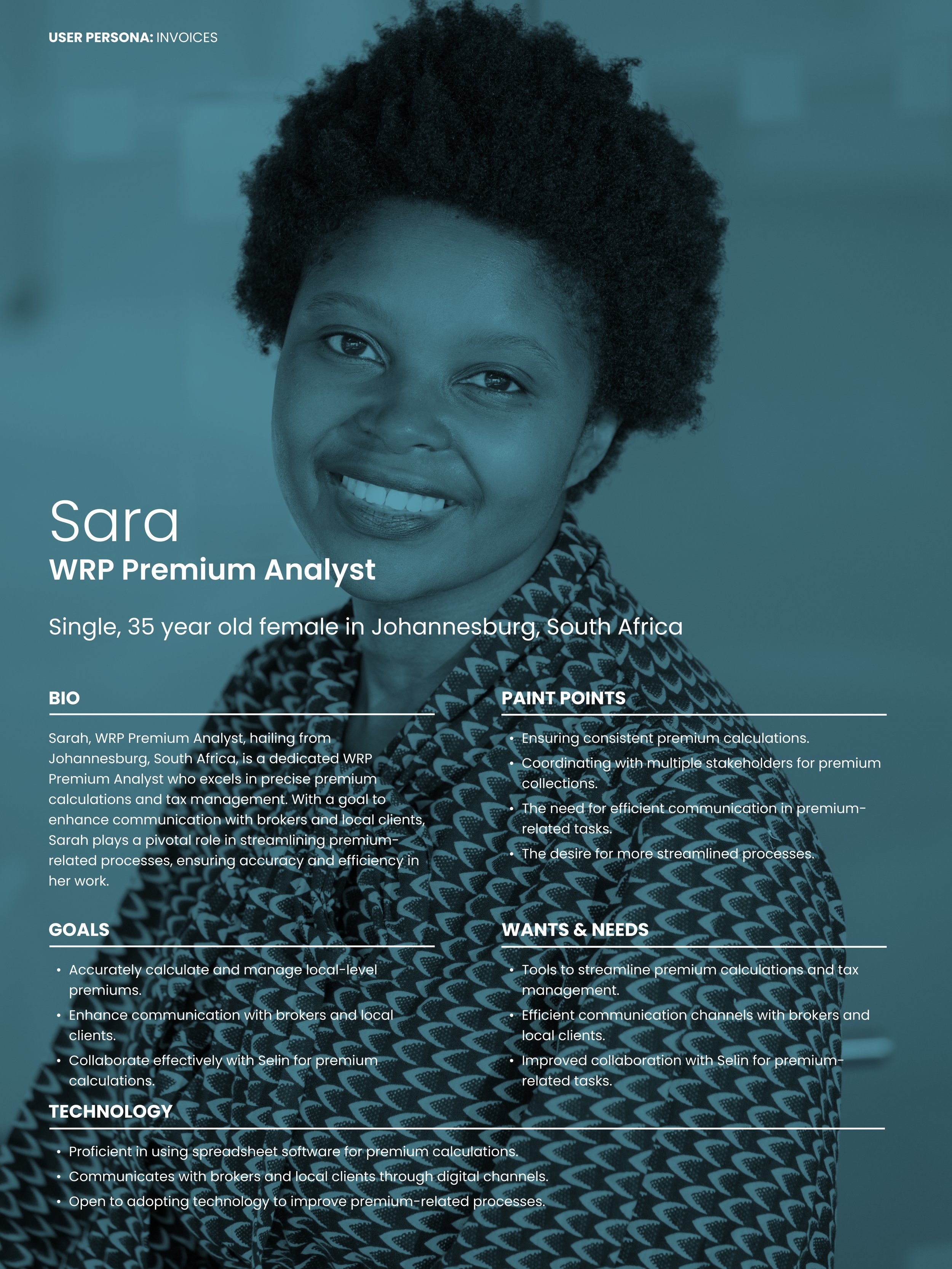
Sara, WRP Premium Analyst The desire for more streamlined processes
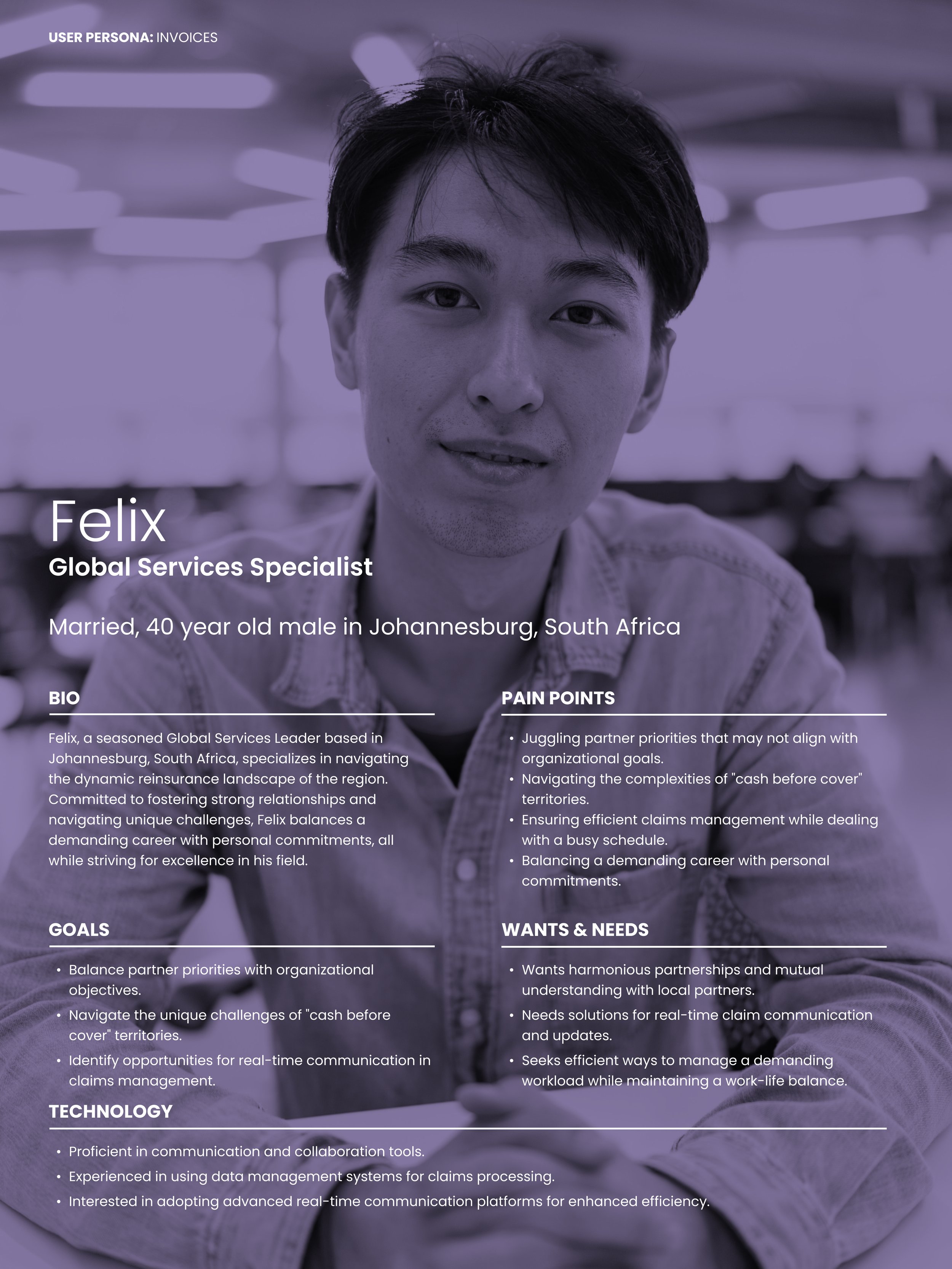
Felix, Global Services Specialist Navigating the complexities of "cash before cover" territories
Enhancing User Empathy through Exploration of Common Tasks
I aimed to uncover critical emotional and procedural junctures that required FM Global's attention by creating and exploring journey maps for two personas and their routine tasks. For instance, it's essential to understand the anxiety someone like Selin might experience while waiting for updated invoice information for a local account. Additionally, we must recognize the challenges and frustration that Felix may encounter when relying on outdated technology and navigating time zone differences. To ensure the solution's effectiveness, it must address these existing issues while avoiding the possibility of introducing new sources of frustration.
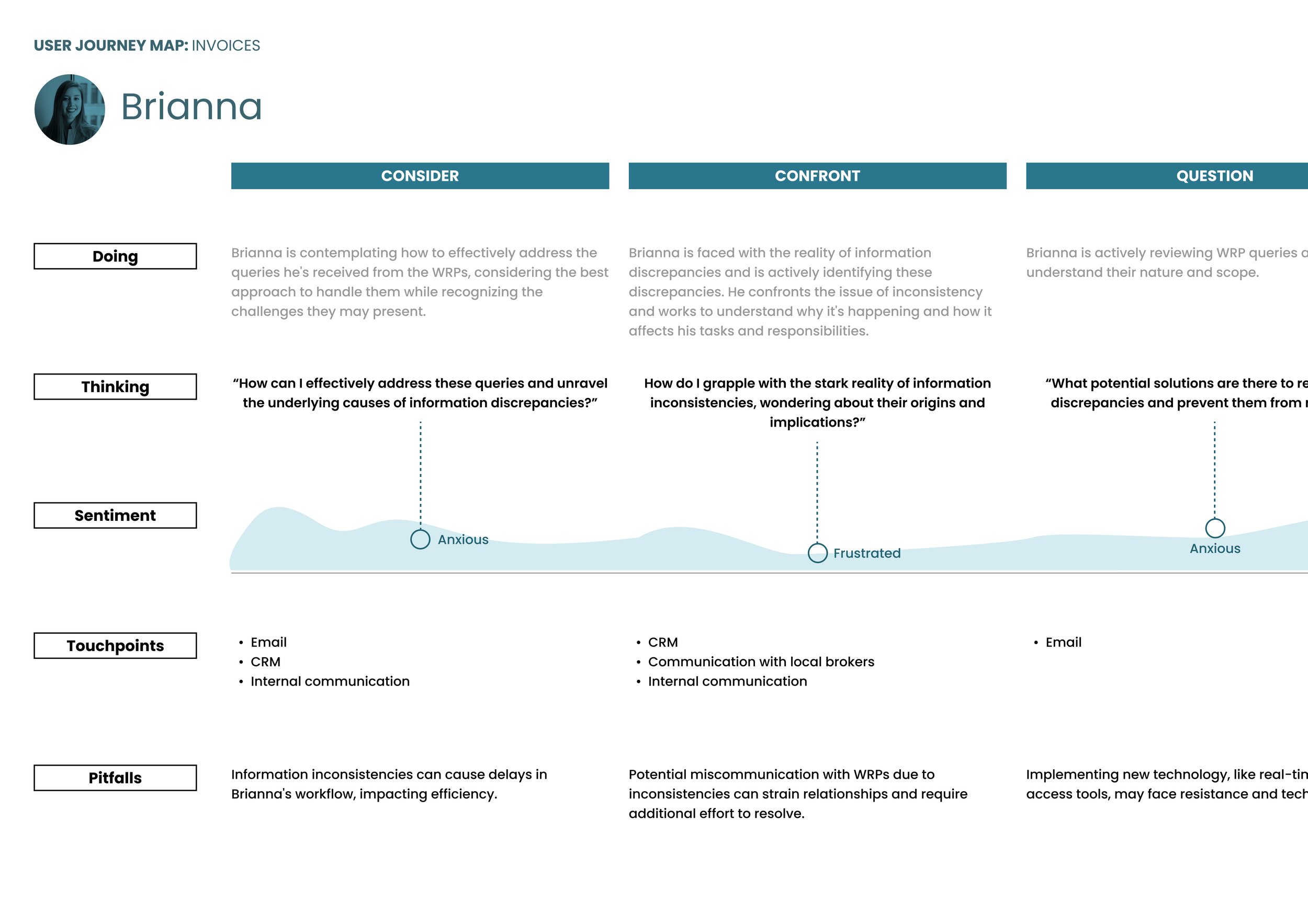
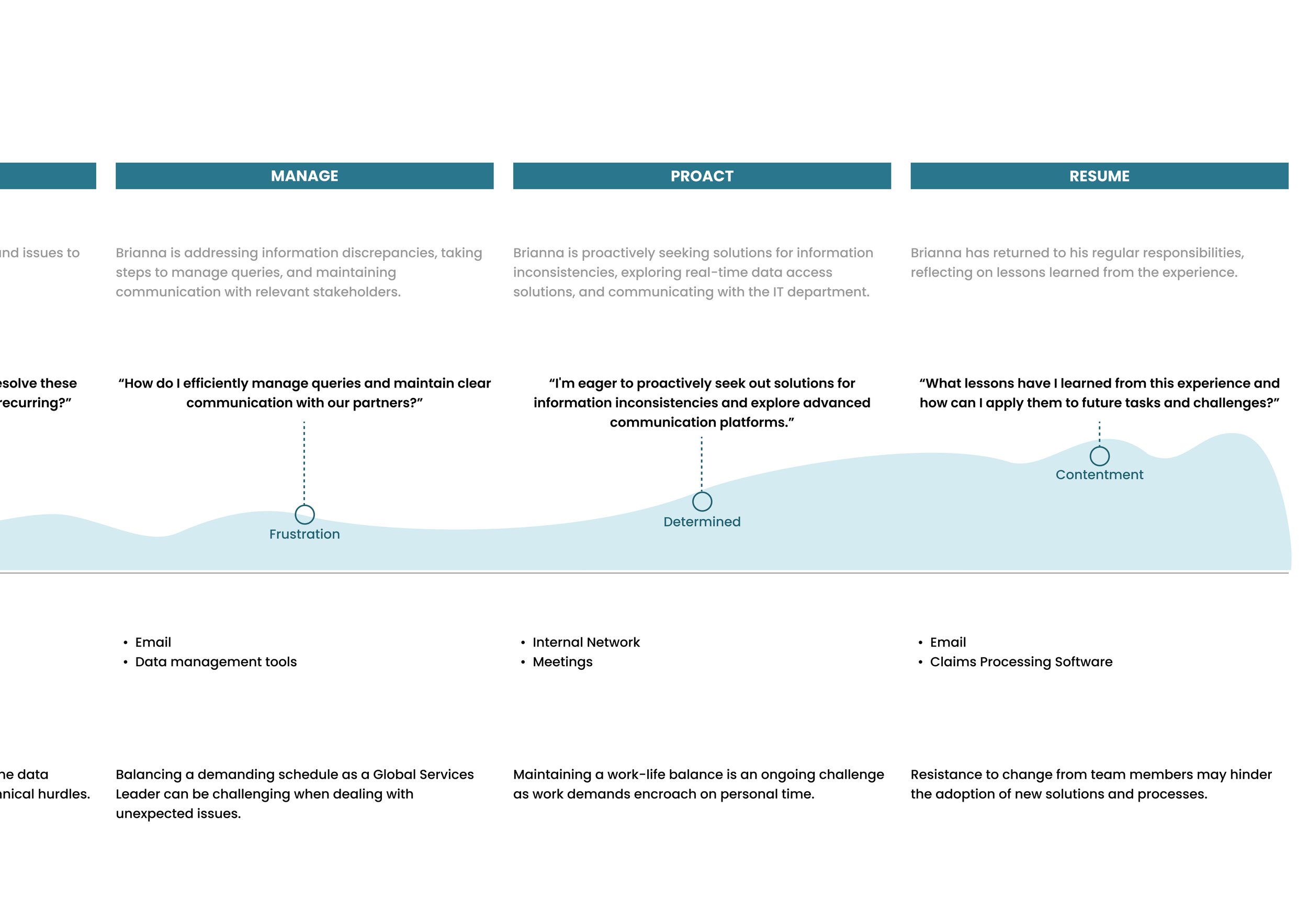
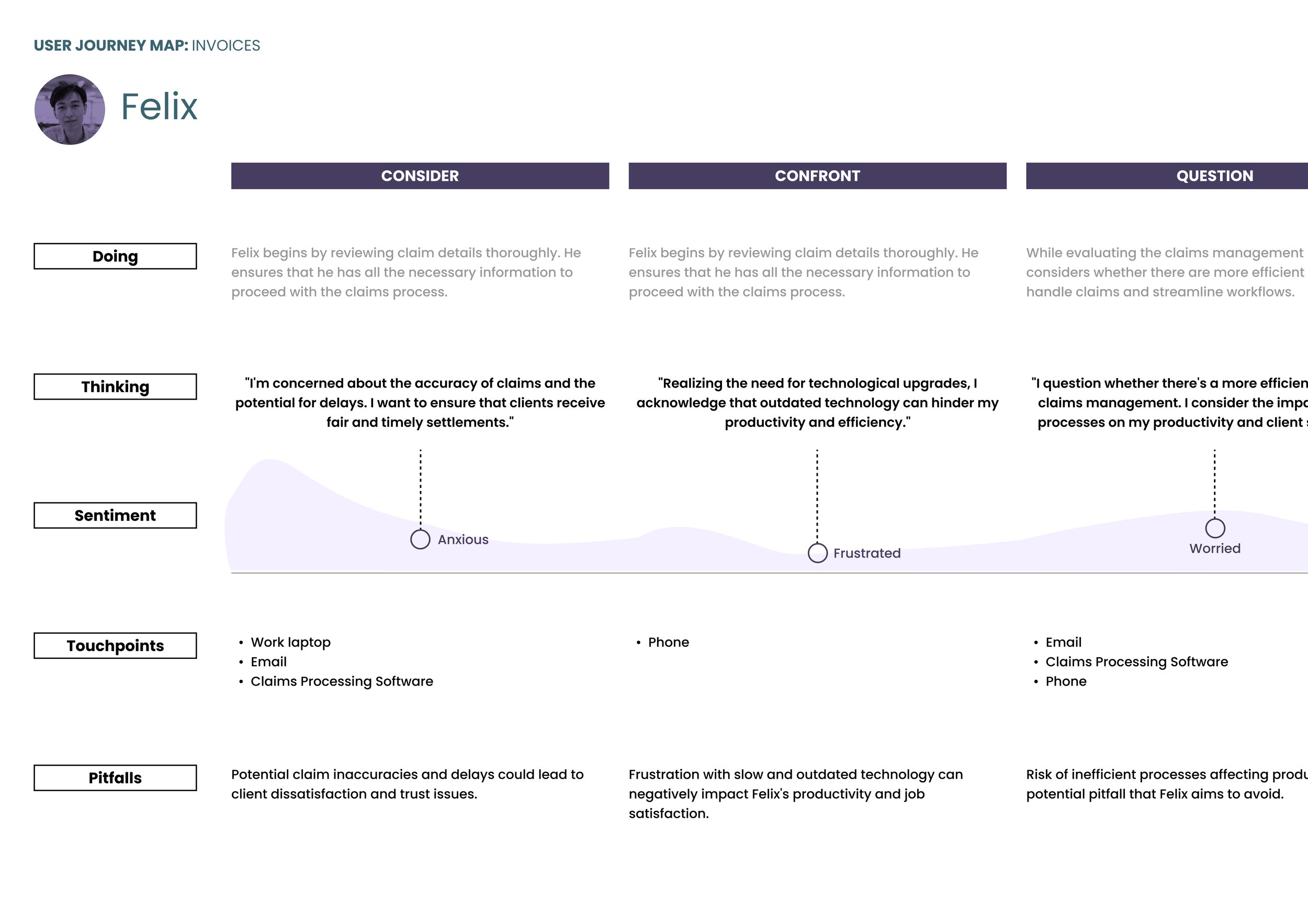

Defining Crucial Workflows
Users expressed that once an invoice is issued or received, they want a streamlined way to monitor its payment status. Priority is given to real-time updates and the ability to access this information from the Policy Connect landing page easily. This workflow illustrates that simplified and direct journey.
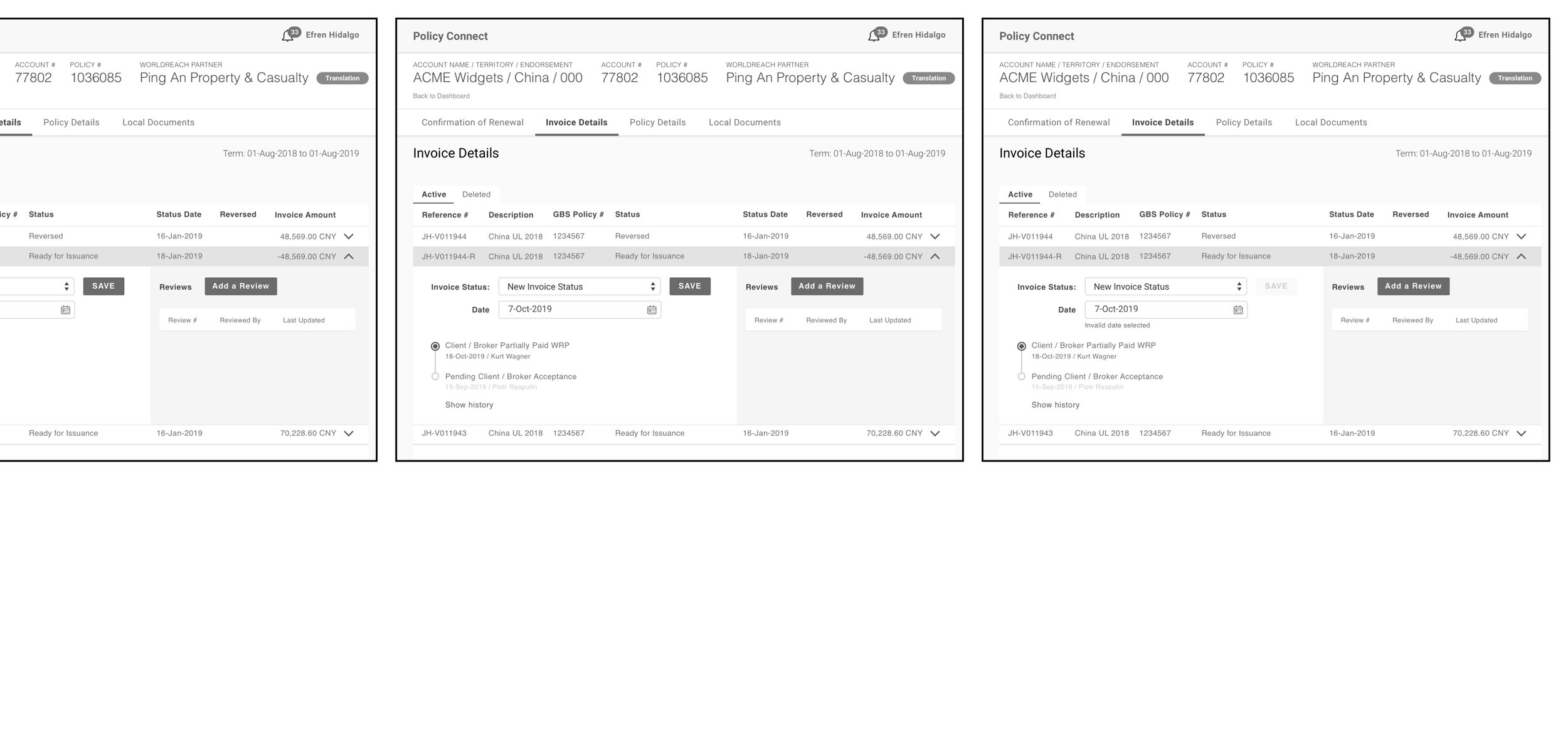

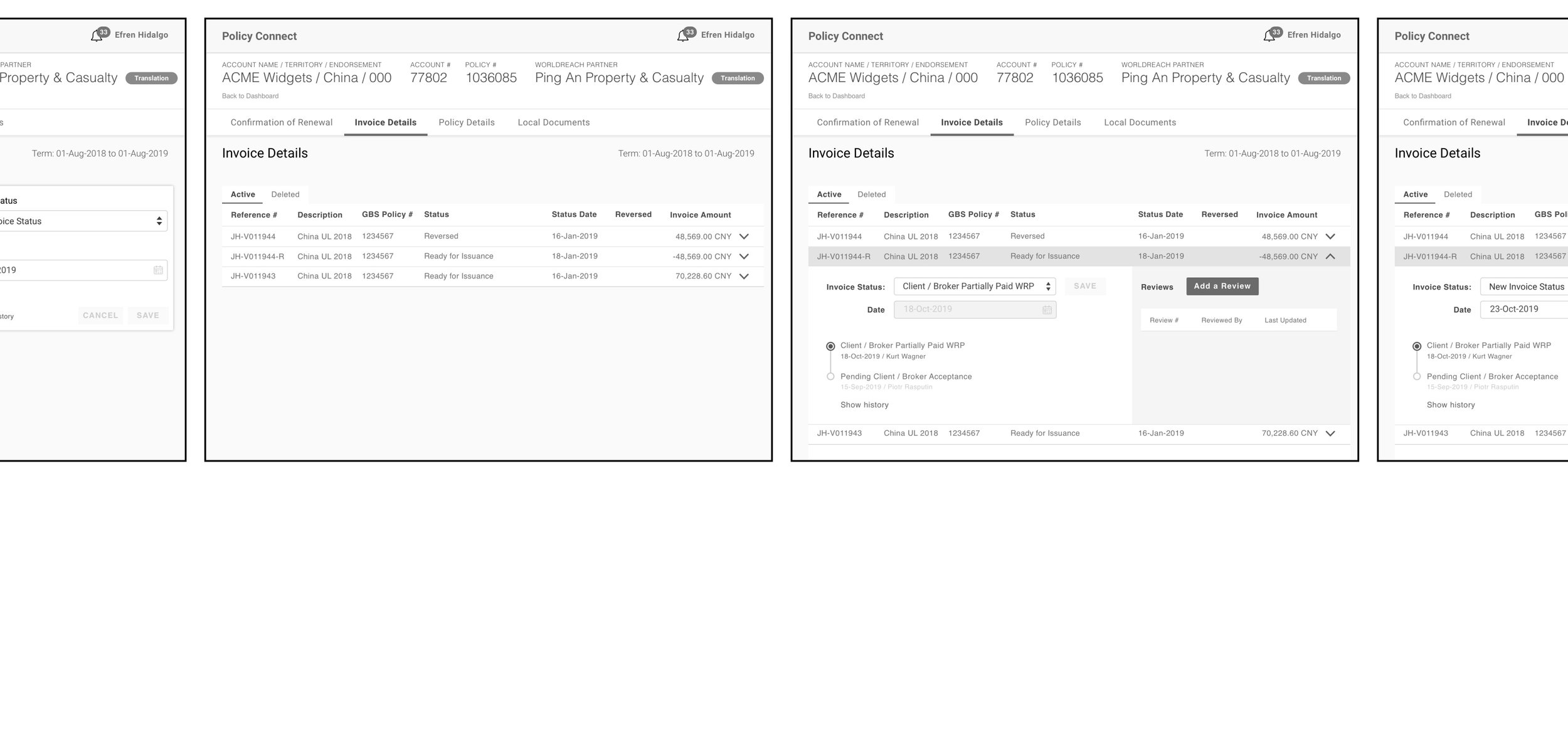
Prioritizing Structural Elements: A Greyscale Approach to Solving Scale and Information Hierarchy Issues
Constrained by tight deadlines, I moved directly from initial conceptual sketches to high-fidelity, greyscale prototypes. This deliberate focus on a monochromatic design palette aided in the identification of issues surrounding both scale and information hierarchy. The lack of color allowed me to hone in on structural nuances, eliminating the distraction of aesthetic elements.
Critical decisions were made concerning prioritizing various design elements within this greyscale environment. The restricted palette simplified the task of deciding which elements required prominence and which could be relegated to a secondary status, thereby optimizing the effective use of available space.
Upon conducting user tests of these wireframes, it became evident that certain aspects of the language were confusing. Additionally, users had specific functional expectations not met in the initial design. These findings were invaluable, highlighting the limitations of a fast-tracked prototyping process and emphasizing the importance of iterative feedback in fine-tuning the design.
Evaluating the Efficacy of User Interactions: Insights from High-Fidelity Prototyping
Utilizing high-fidelity prototypes facilitated a thorough evaluation of key user tasks that were pinpointed during the research phase. While the majority of the user interface components performed adequately, the testing process revealed specific areas that merited reevaluation. Notably, the arrangement and density of information on the confirmation screens led to instances of user confusion.
Lessons Learned: Gaining Insights for Continuous Improvement
In the dynamic landscape of financial transactions and multi-team collaborations, our project—focused on streamlining and improving the invoicing and payment processes for FM Global Operations and our WorldReach Partners—served as a litmus test for understanding how well our existing systems meet real-world demands. This project wasn't just about overcoming the technological barriers we faced; it was an exploration into the evolving expectations of our users, the ergonomics of data display and interpretation, and the intricate balance between system capabilities and user needs.
Our journey through the maze of existing systems, user expectations, and stakeholder demands has revealed gaps, opportunities, and enlightening insights that are valuable for refining the Policy Connect platform and serve as guiding principles for future initiatives. This deep dive into the lessons learned will provide a nuanced understanding of our challenges, achievements, and the roadmap for what lies ahead in our continuous strive for excellence.
The observations from this project reiterate the importance of a holistic approach, where technological solutions are tightly interwoven with human behavior and expectations. Understanding that technological adoption is not merely a 'switch-flip' but a gradual process of integration and habituation was vital.
Here, we break down our lessons into ten crucial points, each offering a multi-dimensional view that addresses the 'what' and the 'why,' enabling us to build more user-centric, effective, and sustainable solutions moving forward.
By delving into these insights, we aim to foster a culture of continuous improvement, always remembering that each project is a learning experience that contributes to our overarching goal: to provide seamless, efficient, and satisfying experiences for both our internal teams and external partners.
Importance of Real-time Information: The demand for real-time updates regarding invoice status became exceedingly clear, reiterating the need for systems that instantly provide this information.
User Expectations: As Policy Connect became more integral to workflows, expectations from internal teams and WorldReach Partners (WRPs) evolved over time. This taught us that user expectations are not static and must be continuously re-evaluated.
Challenges in Existing Systems: We gained an in-depth understanding of the limitations of using WIT and manual methods like spreadsheets. This reinforced the need for a unified, easy-to-use platform.
Need for User Segmentation: Different users have different needs, pain points, and technology comfort levels. This project underlined the importance of creating user personas for more targeted solution development.
Data Display and Interpretation: The high-fidelity prototyping revealed how grouping and displaying information can significantly impact user comprehension and overall experience.
Influence of Ethnographic and Demographic Factors: We realized that users from different backgrounds and roles may interact with the system differently, indicating a need for a more adaptable UI/UX.
Iterative Feedback is Crucial: Iterative prototyping and concept testing were indispensable in transforming conceptual ideas into tangible deliverables. However, more work needs to be done to integrate real-time data, possibly through APIs in the future.
Stakeholder Communication: Effective communication across multiple teams, especially between technical and non-technical stakeholders, is crucial for the project's success. This has been a recurring theme and continues to be an area for improvement.
Future-proofing: With technology continuously advancing, the project made it evident that any solution should solve current issues and be adaptable for future needs.
Business Implications: While the design received positive initial feedback, there is an awareness that the real business impact will be assessed once WRPs can integrate their financial systems into ours.





